Tsukiji Fish Market – Tokyo’s Best Seafood Market That Everyone Should Visit
When you think of Japan, you think of fresh seafood. And when you think of a fresh seafood market in Tokyo, Tsukiji Fish Market would definitely come to mind. Prior to 2018, Tsukiji Fish Market was recognised as the largest wholesale seafood … Continue reading
40 Restaurants In Singapore Where You Can Earn Up To 14 Miles Per Dollar
Formerly known as the Kris+ Gastronomy Series, the promotion is back again this year as Feast To Fly and it offers you the chance to earn an insane amount of miles by dining at participating restaurants in Singapore. From now … Continue reading
Lau Wang Claypot Has Closed Its Original Outlet In Serangoon Central
Lau Wang Claypot has closed its original outlet in Serangoon Central. It first started as a small stall in Yishun before opening its full-fledged eatery in Serangoon. Lau Wang is best known for its variety of yummy claypot dishes that … Continue reading
Sembawang Confectionery – Old-School Bakery At Beach Road With 60 Years of History
Sembawang Confectionery is a humble old-school bakery tucked away at the ground floor of a HDB estate at Beach Road, not Sembawang. This bakery has been rolling out freshly baked bread and cakes since the 1960s. Best of all, their … Continue reading
Popular Taiwanese Croissant Brand Hazukido Is Opening In Singapore
Popular Taiwanese coissant brand Hazukido will be opening its first store in Singapore by August 2024 at the basement of Ngee Ann City. Established in Taiwan, Hazukido offers a wide range of exciting flavoured Japanese-style croissants. They currently have outlets … Continue reading
Yoyogi Pony Park – Free Pony Rides For Children In Tokyo
Contrary to popular belief, Tokyo is actually home to a decent number of child-friendly activities that both locals and tourists can enjoy. For those who are looking for animal-based activities but aren’t keen on such experiences indoors, you need to include Yoyogi … Continue reading
Cafe Gyoen – New Japanese Cafe With Train Decor In Serangoon Gardens
Cafe Gyoen is a new Japanese-themed cafe in Serangoon Gardens with a train decor. Taking over the space vacated by Isshin Machi, Cafe Gyoen will transport you to the Tokyo metro stations and train cabins! Opened by the same owners … Continue reading
Dona Manis Cake Shop – Famous Banana Pie at Katong Shopping Centre
Objectively, when one thinks of the food enclave at Katong, Katong Shopping Centre wouldn’t come to mind. And if you’re a fan of bananas, you’ve been missing out. Dona Manis Cake Shop is a small and humble 28-year-old bakery nestled within … Continue reading
Joe’s Thai Kitchen – Authentic Thai Eatery By A Thai Chef At Alexandra Village
For those who are working in the Bukit Merah and Alexandra neighbourhoods, you’d definitely know how difficult it is to find a spot to dine at (and one which serves up good food) during the lunch hour. With the eatery’s … Continue reading
Ami Patisserie – New French-Japanese Patisserie With S$118 Dessert Omakase
Housed within a colonial building—inspired by the Kyo Machiya, traditional wooden townhouses in Kyoto—along Scotts Road, Ami Patisserie is a Japanese-French patisserie by Chef Makoto Arami which specialises in European-style pastries and desserts made with premium Japaneese produce. It started … Continue reading
Le Matin Patisserie At ION Orchard To Close On 29 Feb After A Year
Popular upmarket patisserie, Le Matin Patisserie is closing its flagship outlet at ION Orchard after opening for just a year. Helmed by Chef Mohamed Al-Matin who has previously worked at Noma, Restaurant Andre, Black Star Pastry, Zumbo, Le Matin Patisserie first … Continue reading
Kiroi Freshly Baked Cheese Cake – Hidden Japanese Cheese Cake Shop At Alexandra Village
Kiroi Freshly Baked Cheese Cake is a classic Japanese bakery located within Alexandra Village which specialises in baking fluffy and creamy Japanese cheesecakes. Helmed by Donald and Joanne, a couple who left their full-time jobs in search of a livelihood that … Continue reading
Sunday Folks Is Closing Their Outlet At Chip Bee Gardens After 10 Years
Popular ice cream and waffle cafe, Sunday Folks will be closing their outlet at Chip Bee Gardens on 29 Feb 2024 after serving the residents in the neighbourhood for the last 10 years. Beautifully swirled on a cone or on … Continue reading
GRUB Burger Bistro Is Reopening A New Outlet In Bishan-Ang Mo Kio Park
Good news for fans of GRUB Burger Bistro who are residents in the Bishan and Ang Mo Kio neighbourhoods, the casual neighbourhood eatery is reopening in Bishan-Ang Mo Kio Park after closing its previous location back in Jan 2022. It … Continue reading
1932 Story Cafe – 1930s-Themed Cafe At The Bukit Timah Railway Station
If you’re still contemplating whether to pay a visit to the iconic Bukit Timah Railway Station, a meal at 1932 Story Cafe should be good enough reason to start planning your visit. For the uninitiated, 1932 Story Cafe is a 1930s-themed cafe which … Continue reading
Century Bak Kwa – The Best Premium Charcoal-Grilled Bak Kwa In Singapore
Lunar New Year is just around the corner and it’s time to buy and order your favourite Bak Kwa if you haven’t already done so. Bak kwa, commonly referred to as rou gan, is our all-time favourite CNY snack and … Continue reading
Balmoral Bakery – The Best Traditional Bakery at Sunset Way Since 1965
For those who live in Clementi, Balmoral Bakery is an old-school bakery that would be no stranger to you. With roots dating back to the mid-1960s, Balmoral Bakery is well-loved for their baked pastries and fluffy cakes. If you’re not sure … Continue reading
Sing Hon Loong Bakery – Probably The Last 24/7 Traditional Bakery In Singapore
In this day and age, you don’t often come across bakeries that are open 24 hours every day. Sing Hon Loong Bakery is a traditional bakery at Whampoa which sells old-school buns throughout the day. Yes, that’s right; all day, every … Continue reading
Koh Grill & Sushi Bar – Japanese Eatery Known For Shiok Maki Has Closed After 17 Years
Koh Grill & Sushi Bar, a casual Japanese eatery nestled in Wisma Atria’s Food Republic, offers Japanese cuisine at reasonable prices. Their standout dish, the Shiok Maki, keeps customers coming back for more. The famous Shiok Maki eatery has closed … Continue reading
Ng Kim Lee Confectionery – This Old-School Bakery In Beauty World Has Been Around For 60 Years
For those who grew up in the West side of Singapore, Ng Kim Lee Confectionery would be a name familiar to you. A family-run bakery situated along Chun Tin Road, Ng Kim Lee Confectionery is known for selling Teochew-style pastries … Continue reading
Potato Potage Recipe
Potato Potage, a French dish crafted from potatoes and other ingredients to produce a luxurious and velvety soup, has gained enduring popularity in Japan over many decades. This European-influenced soup has seamlessly integrated into Japanese cuisine and is frequently relished as a complement to Western-style dishes, including classics like Beef Steak and Hamburger Steak.
The name “Potage” comes from its original meaning, “something put in a pot.” This soup is typically slow-cooked in a pot and, at the end, mixed in a blender to achieve a smooth texture. In Japan, potage is also recognized as a distinctive type of soup, specifically characterized by a cream-like consistency achieved by combining vegetables with milk or cream. When it comes to potage enjoyed by people of all ages and genders in Japan, Corn Potage stands out as a uniquely Japanese creation. Potato Potage, however, is also a favorite often featured on the menus of Western restaurants. Since soups like Miso Soup or Sumashijiru are commonly part of Japanese meals, potage has seamlessly integrated into Western-style Japanese dining experiences.
Potage is also a popular home-cooked dish in Japan. Its smooth texture and rich flavor go well with bread, and it is often served with rolls or croutons. Making potage is quite simple with just a few ingredients, and we’re sure many will find success on their first attempt. Potato Potage is hearty enough to be a light main dish, making a perfect meal when paired with rolls and salads. We hope you give it a try!

Potato Potage
Ingredients
- 14 oz potato 2-3 medium
- 1/2 brown onion medium
- 2 Tbsp butter
- 1 Tbsp flour
- 2 cups chicken broth
- 1 cup milk
- 1/2 tsp salt
- 1/8 tsp white pepper
- chopped parsley
Instructions
- Peel potatoes and cut into small pieces. Slice onion thinly.
- In a heavy pot, melt butter at medium heat and cook onion until tender. Sprinkle flour and cook for a minute. Add chicken broth and potatoes, cover, and cook for 10-15 minutes until the potatoes get soft.
- Transfer the soup to a blender, and process until very smooth. Put the soup back in the pot, and add milk, salt, and pepper. Stir and cook until just before boiling.
- Serve with chopped parsley.
Video
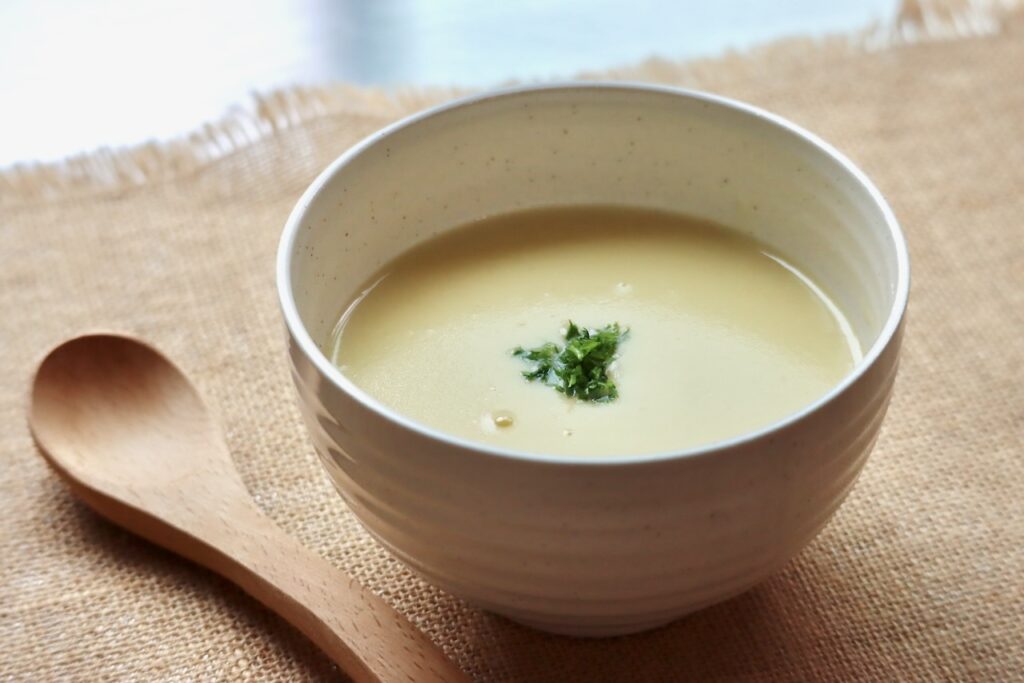
Tuna Mayo Rice Bowl
Tuna-mayo is a simple tuna salad that consists of canned tuna and Japanese mayonnaise, and tuna-mayo rice bowl (ツナマヨ丼) is an easy donburi rice bowl dish with tuna-mayo placed on a bowl of steamed rice. Tuna-mayo is one of the most popular fillings for Onigiri rice balls sold at any convenience stores in Japan. Creamy yet a bit tangy and salty Japanese tuna salad goes really well with steamed rice, and the flavor combination of tuna, mayo, rice, and nori seaweed is somewhat addictive. While Tuna Mayo Onigiri can be an excellent grab-and-go lunch in Japan, sadly not everyone is lucky to have convenience stores that sell such Onigiri nearby (certainly not where we live in the U.S.)
While we can make Tuna Mayo Onigiri at home following our own recipe, when we are short on time or simply too lazy to make rice balls, why not just make the tuna salad and place on top of cooked rice with some nori seaweed? The flavor is the same anyway. Even better, top with some chopped green onions for a bit of freshness and some chili oil for a kick. There is no real cooking involved here, and it takes no time to prepare for this delicious lunch at home!
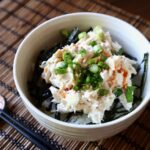
Tuna Mayo Rice Bowl
Ingredients
- 5 oz canned tuna drained
- 3 tbsp mayonnaise Japanese mayonnaise preferred
- 1/8 tsp salt
- 2-3 cups steamed rice
- 1 sheet nori seaweed shredded
- 1 green onion chopped finely
- La-yu chili oil to taste optional
Instructions
- Mix canned tuna (drained well), mayonnaise, and salt in a small bowl. Serve steamed rice in individual bowls and top with the tuna salad, shredded nori seaweed, chopped green onion, and la-yu chili oil (optional).
Video
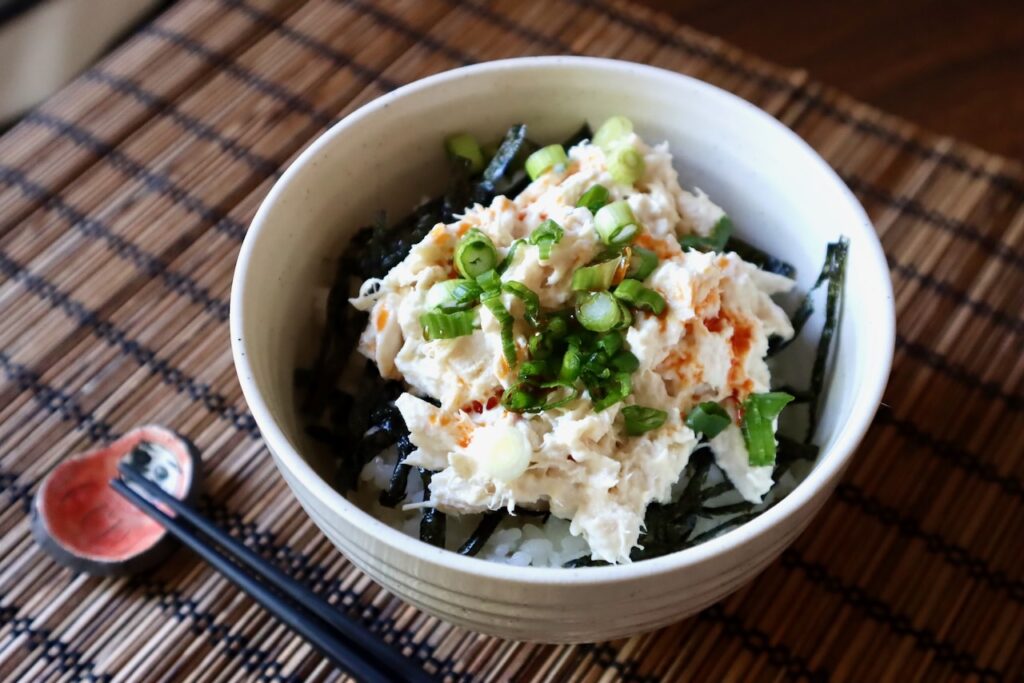
12 Best Miso Soup Recipes That Are Easy To Make
Miso Soup (味噌汁) is a traditional Japanese soup, and it’s served with any Japanese meal at any time of the day. Tofu and wakame seaweed miso soup is probably the most well known and popular, but the possibilities of ingredients are endless. You can use all sorts of meat, seafood, eggs, and vegetables that you already have in your fridge at home.
If making Dashi stock from scratch sounds too much work, you can use instant dashi packet or powder that are readily available online and at supermarkets. They are very convenient and flavorful, and we use it, too, on a regular basis. Most of our miso soup recipes are ready in 15 to 20 minutes! Hope you can try one of our simple and easy recipes below, or you can come up with your own combinations of ingredients.
Get Instant Dashi on Amazon (Commissions Earned)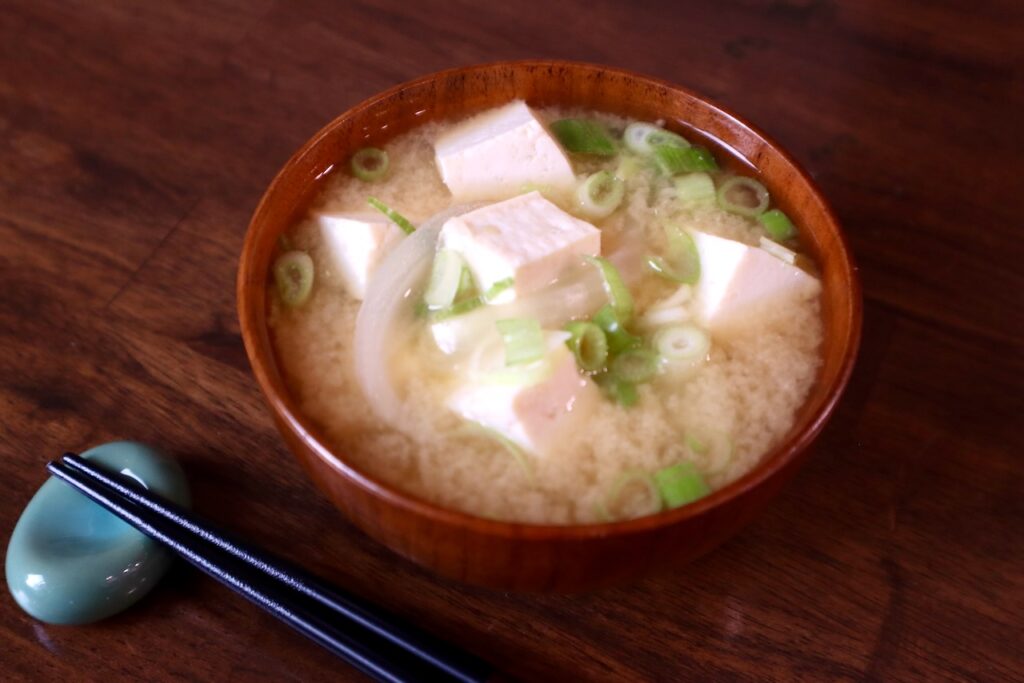
Miso Soup with Tofu and Onion
We added sliced brown onion to a typical tofu miso soup in this recipe. Thinly sliced brown onion adds sweetness to the broth. If you are tired of a typical tofu miso soup, try adding brown onion for a change!
Get the Miso Soup with Tofu and Onion Recipe.

Miso Soup with Steamed Rice
Steamed rice gives miso soup some body, by very slightly thickening it. It is still a soup, not Okayu porridge or Zosui. It’s a perfect dish when you’re not feeling well and have no appetite. This simpler and milder soup is easy to take in, but it’s still got some substance to give your body energy.
Get the Miso Soup with Steamed Rice Recipe.
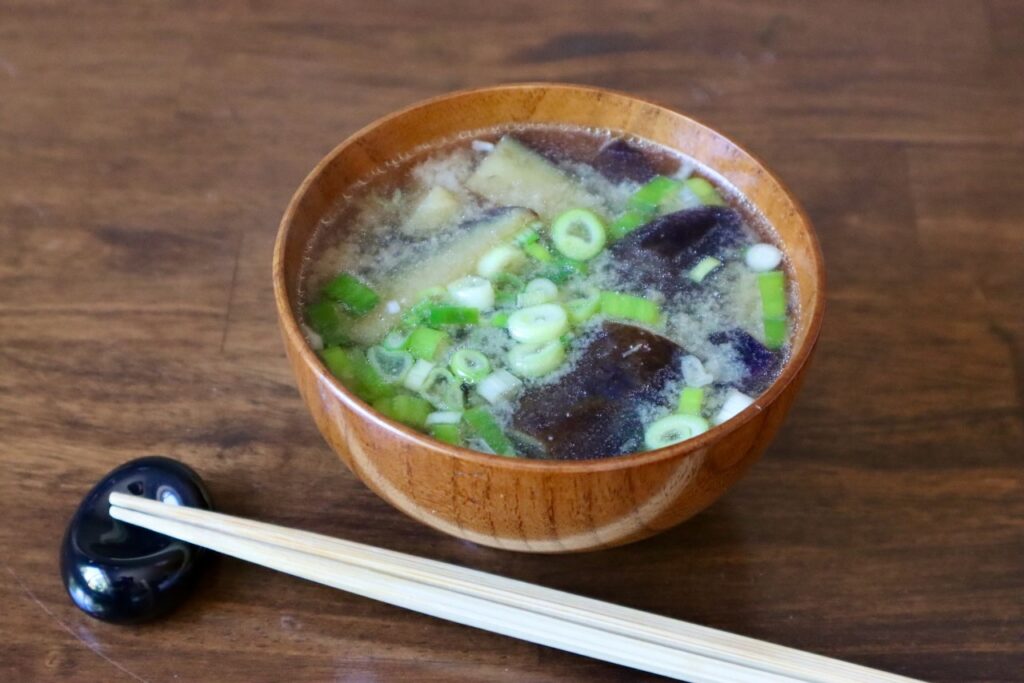
Miso Soup with Fried Eggplant
Japanese eggplant is cut into thick sticks and pan fried with oil before added to the broth. Softly cooked eggplant soaks up savory dashi and miso flavor.
Get the Miso Soup with Fried Eggplant Recipe.

Miso Soup with Soy Milk
Miso paste and soy milk are both made from soy beans, and of course they blend in perfect harmony. Together with Abuuraage thin fried Tofu, this is a triple soy-licious dish! Because Kombu sea kelp Dashi and Shimeji mushrooms add extra depth to the flavor, there’s no need to add any animal-derived ingredients.
Get the Miso Soup with Soy Milk Recipe.
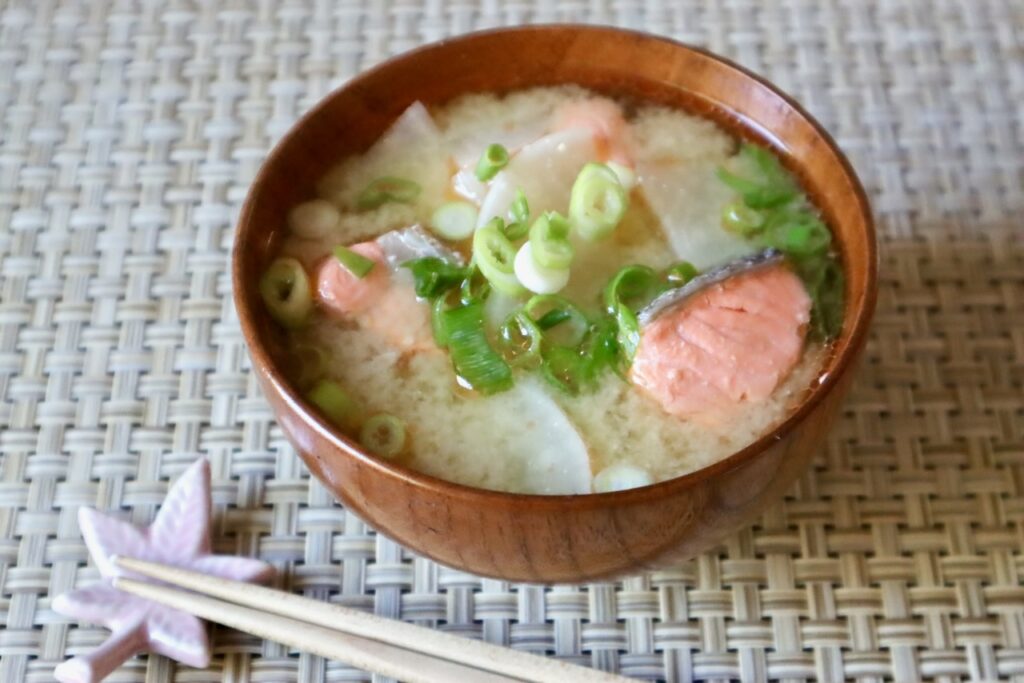
Miso Soup with Salmon and Daikon
Fresh salmon fillet is cut into bite size pieces and cooked with daikon radish in savory dashi broth and seasoned with miso paste. Daikon is a long white Japanese radish, and it’s used in a variety of Japanese dishes such as pickles, salad, stew, and soup. As the name Daikon in Japanese literally means “large root” (大根), once you buy a whole daikon, it can be transformed into multiple dishes. Miso soup is a great way to use up a leftover piece of daikon in the fridge.
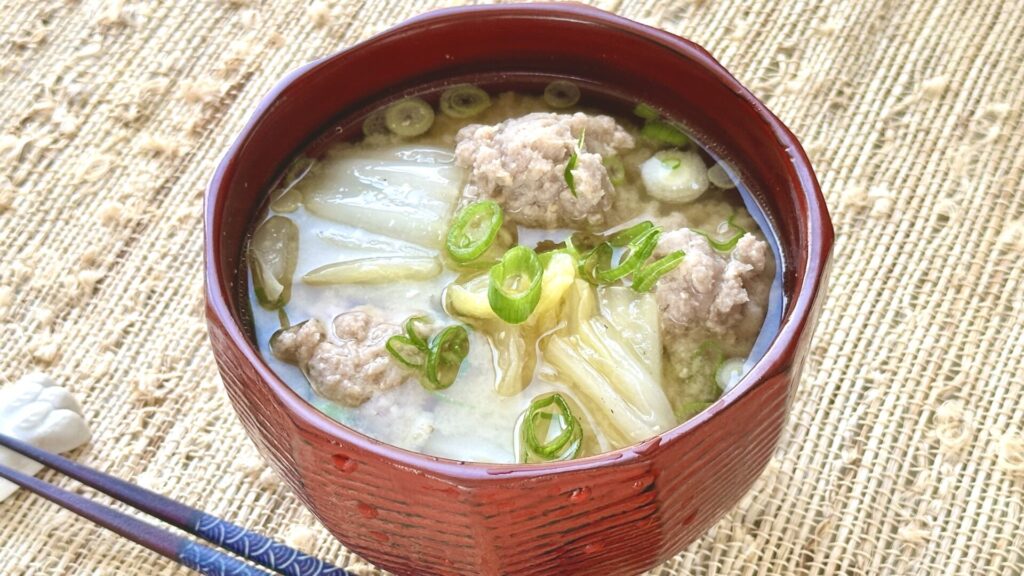
Miso Soup with Pork Meatballs
This is a hearty dish that can easily serve as a main course alongside steamed rice. There’s no need to make Dashi for this miso soup as the ground pork provides enough umami savory flavor. Napa cabbage adds a delightful texture and makes the soup both filling and healthy.
Get the Miso Soup with Pork Meatballs Recipe.
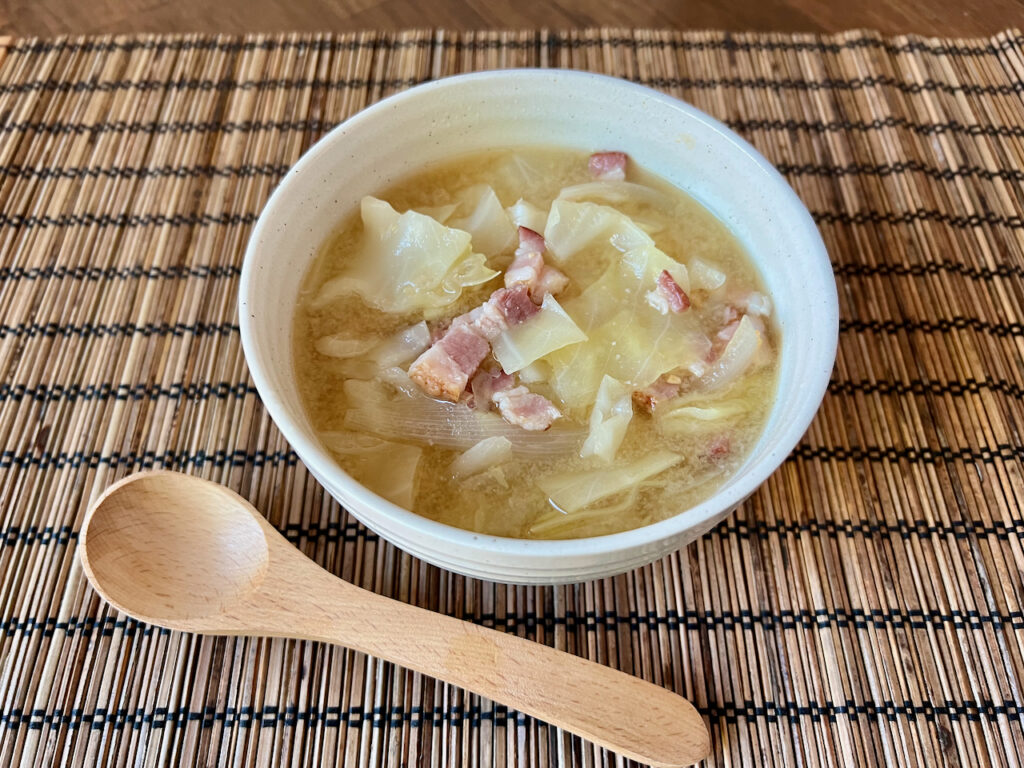
Miso Soup with Bacon, Cabbage, and Onion
Bacon is commonly used in western style soup such as chowder and minestrone, but it actually goes very well with Japanese miso soup, too! Dashi is almost not needed as the bacon has strong flavor, but we are adding instant dashi powder to the broth for added umami.
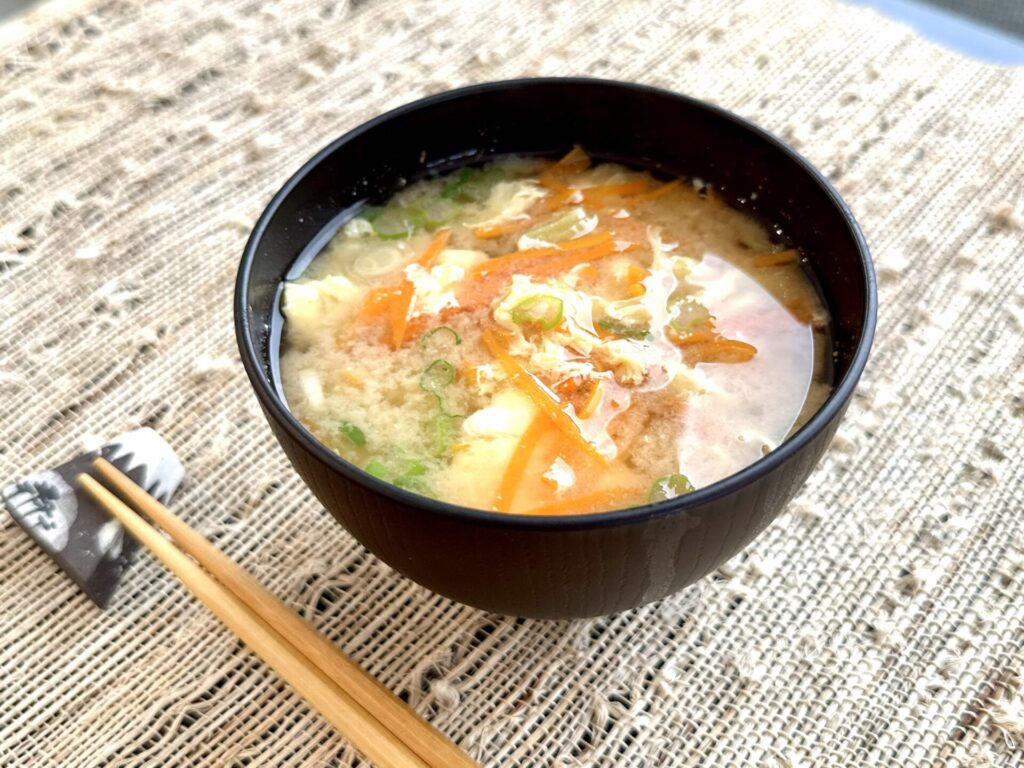
Miso Soup with Carrot and Egg
This miso soup is definitely an everyday dish with simple ingredients that are already in your fridge. The sweetness from the carrot makes the taste of the soup nice and mild, and the fluffy egg is irresistibly tempting. You can make this miso soup at a moment’s notice.
Get the Miso Soup with Carrot and Egg Recipe.
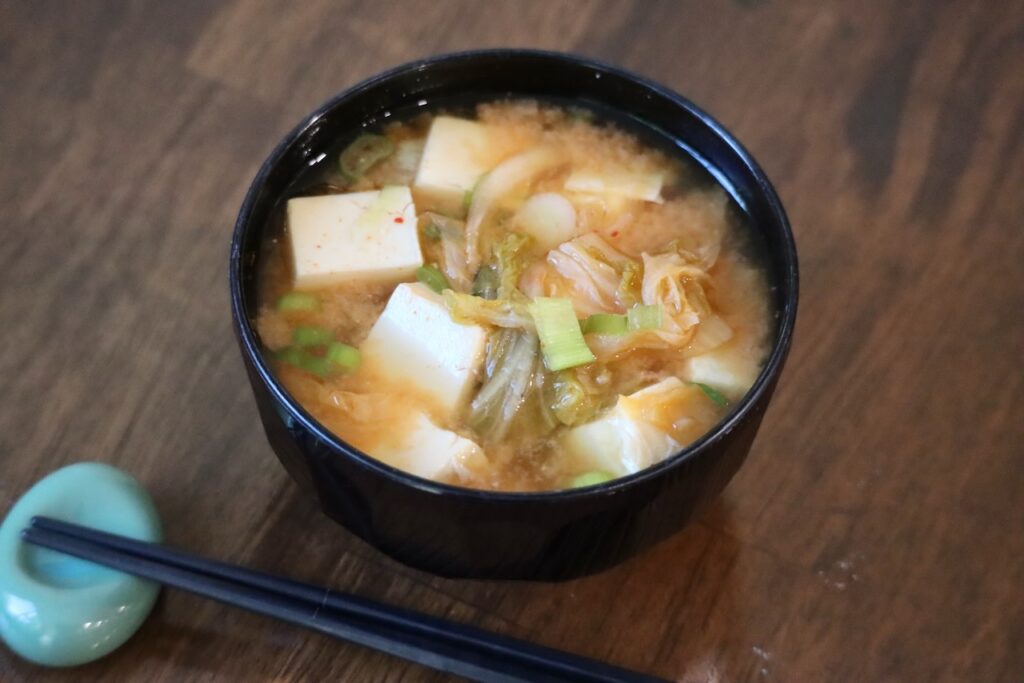
Miso Soup with Kimchi and Tofu
This miso soup is inspired by Korean Kimchi soup or Kimchi Jjigae, but it is not the authentic Korean soup. It’s rather a simple Japanese miso soup with kimchi in it. It’s lighter and milder than jigae (Korean stew). You can have the soup simply as it is, or add some thinly sliced pork, seafood, or eggs to make it heartier.
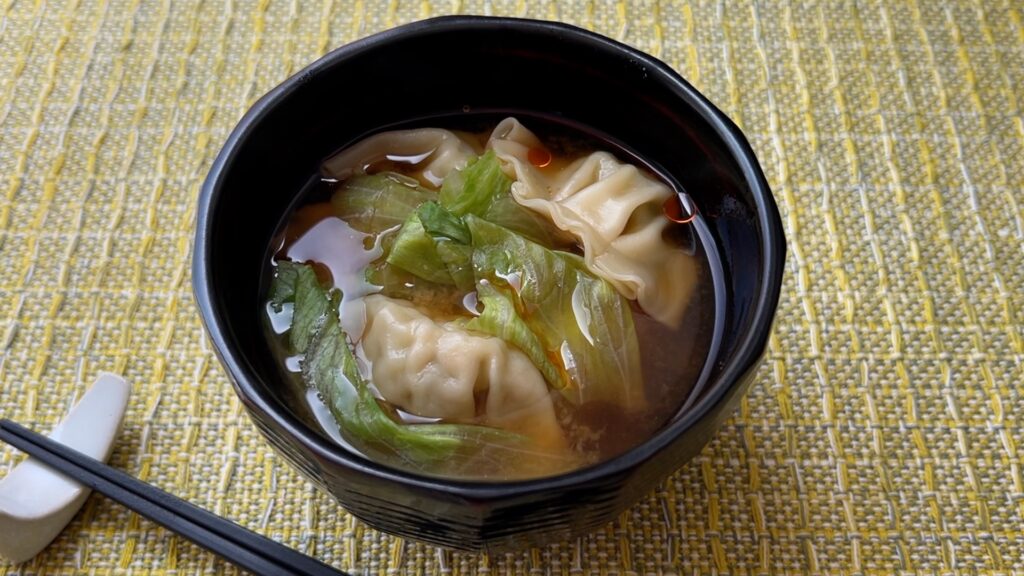
Miso Soup with Gyoza and Lettuce
This miso soup is made with store-bought frozen Gyoza and fresh lettuce. It is seriously easy to make, and you don’t even need to cut anything at all. Choose frozen Gyoza dumplings of your choice, chicken, pork, or vegetable, from super markets, throw them in the soup along with lettuce leaves, and done! No compromise on the taste either.
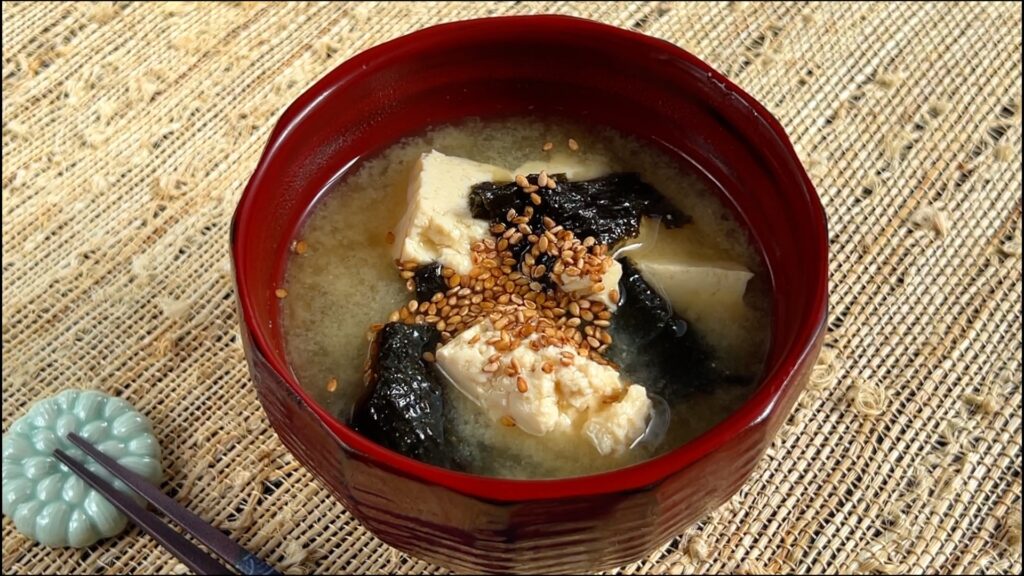
Miso Soup with Broken Tofu and Nori Roasted Seaweed
Medium hard Tofu is broken apart into chunks by hand, and Nori is also torn by hand. No knives and cutting boards are involved. On top of the nice oceanic aroma of Nori seaweed, toasted sesame seeds give the soup another layer of nice fragrance. And all is done in 10 minutes – that’s not bad at all.
Get the Miso Soup with Broken Tofu and Nori Roasted Seaweed Recipe.
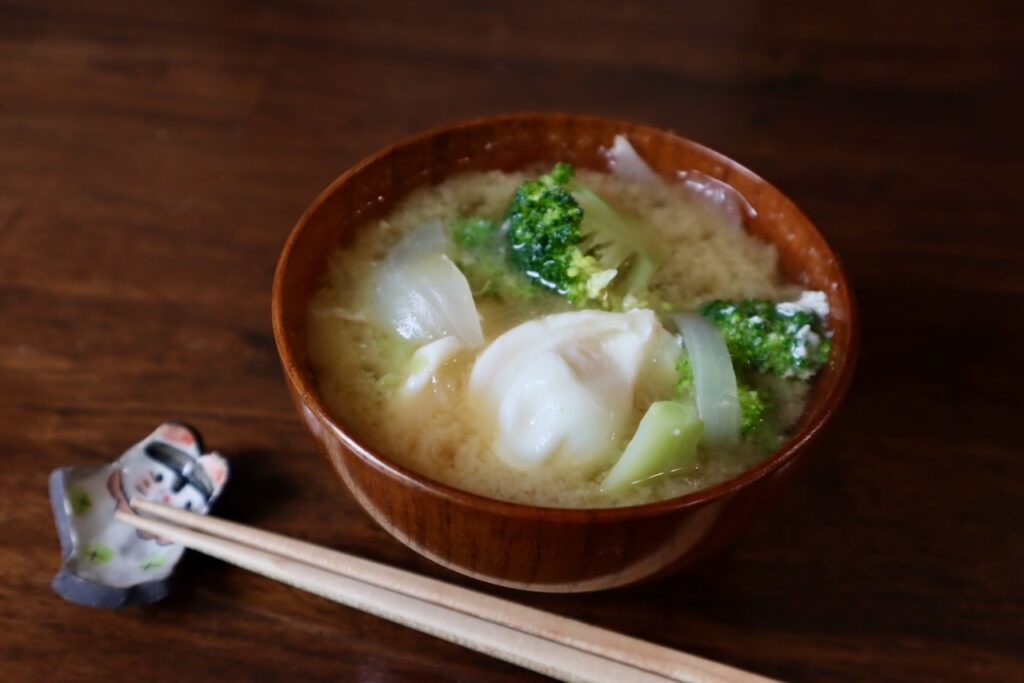
Miso Soup with Broccoli, Onion, and Egg
We can use the whole broccoli including the stems for this miso soup, and onion slices add the sweetness to the broth. This is a perfect soup for breakfast or lunch.

Simmered Daikon with Ground Chicken Recipe
Simmered Daikon with Ground Chicken is a common winter dinner dish in Japan. Thick daikon rounds are cooked until soft and gently seasoned in Dashi soup, then thickened with potato starch. The resulting silky sauce/soup keeps the dish warm while eating, making it a healthy and delightful entrée for cold nights.
Daikon, or Japanese radish, is a white root vegetable widely used in Japanese cuisine and around the world. Typically long and white with a smooth surface, daikon is low in calories, rich in dietary fiber, vitamin C, potassium, and digestive enzymes. While crispy when eaten raw, it becomes soft when cooked. When daikon is cooked in rice washing water, the bitterness is removed from daikon. If you happen to wash rice before you cook the dish, keep the water; it can be used to cook daikon. Otherwise, follow the recipe.
Daikon readily absorbs seasonings and flavors during cooking, making it an excellent companion for steamed rice. In this dish, daikon is cooked with a small amount of chicken, conveying a full and satisfying chicken flavor to the daikon. While Yuzu citrus may be challenging to find outside Japan, its distinctive aromatic flavor complements the daikon dish well. Alternatively, ginger can be used as a substitute for Yuzu, offering a compatible flavor for the wintery thick soup.
Simmered Daikon with Ground Chicken is a quintessential home-cooked dish and may be less commonly found in restaurants. Still, its straightforward yet delicious character makes it a dish worth trying at home. We hope you enjoy it!
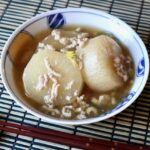
Simmered Daikon with Ground Chicken
Ingredients
Instructions
- Cut the Daikon into 1" thick rounds and peel.
- In a medium pot, add rice and water, and let it boil for a minute. Remove the rice. Add the daikon in the rice water and cook for about 20 minutes until it becomes tender and translucent. Drain the water.
- Cook daikon in Dashi for another 10 minutes, then add salt, sake, mirin, and soy sauce, and cook for 15 minutes, loosely covered. Add ground chicken and break apart, skimming fat and scum with a mesh strainer. If available, add yuzu peel.
- Make a starch slurry in a small bowl and add it to the soup. Stir thoroughly. Cook until the soup thickens.
Video
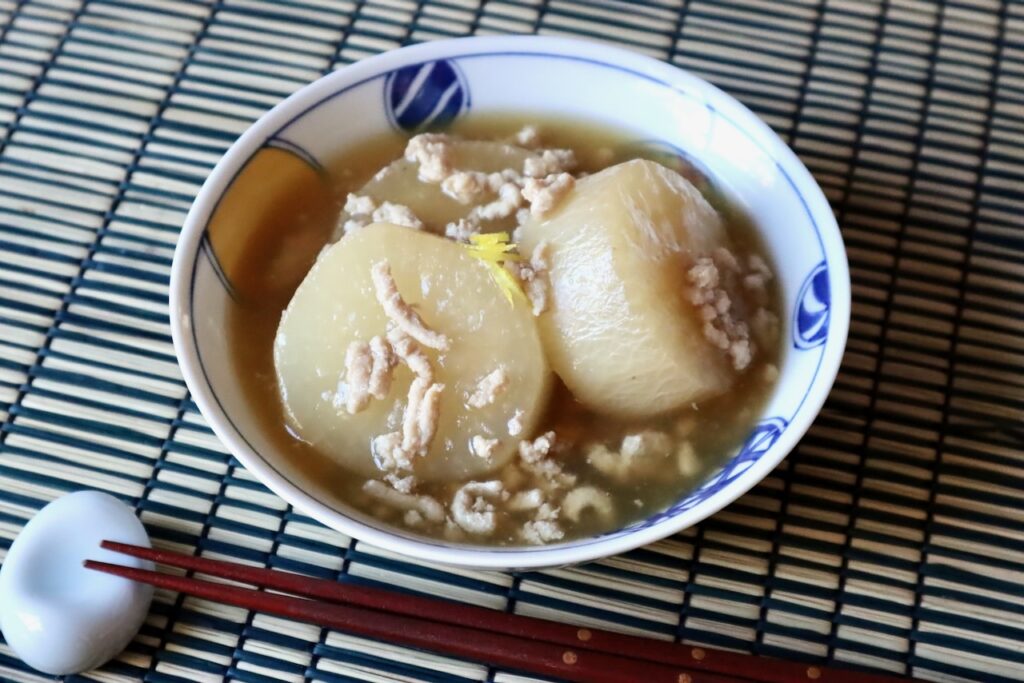
Miso Glazed Eggplant (Dengaku)
Miso Glazed Eggplant (Nasu Dengaku, 茄子田楽) is grilled eggplant rounds topped with a sweet miso sauce. It makes for a great appetizer alongside your favorite drinks such as sake and beer. Additionally, it serves as a delicious main dish that pairs well with steamed rice. The robust flavor of the miso sauce complements the freshness of the juicy eggplant. Feel free to use any kind of miso you prefer, adjusting the amount of sugar and Mirin accordingly. This dish is also vegan-friendly. We hope you give it a try!

Miso Glazed Eggplant (Dengaku)
Ingredients
- 1 eggplant American, large
- 3 Tbsp oil
- 1 tsp sesame seeds
Miso Glaze
- 4 Tbsp Miso Paste
- 2 Tbsp sugar
- 2 Tbsp Sake
- 2 Tbsp Mirin
- 2 Tbsp water
Instructions
- Cut the eggplant into 1" (2.5 cm) thick rounds. Then soak the eggplant slices in water for 10 minutes.
- In the meantime, place all the ingredients for the miso glaze in a pot and cook until slightly thickened. Set aside.
- Remove the eggplant from the water and pat it dry with paper towels. Then, make shallow cuts on the surface of the eggplant slices.
- Heat oil in a frying pan over medium heat, place the eggplant rounds, and cook for 4-5 minutes on each side until very tender. Top with miso glaze and sesame seeds."
Video
Miso Soup with Carrot and Egg
Today’s miso soup is made with carrot and egg. This miso soup is definitely an everyday dish with simple ingredients that are already in your fridge. The sweetness from the carrot makes the taste of the soup nice and mild, and the fluffy egg is irresistibly tempting. You can make this miso soup at a moment’s notice. Hope you like it!
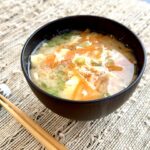
Miso Soup with Carrot and Egg
Instructions
- Slice the carrot into thin match sticks, and thinly slice the green onion. Beat the eggs lightly in a bowl. Set aside.
- Bring the Dashi to a boil, then add the carrot and cook for 2 minutes
- Dissolve the miso paste in the soup and, in a circular motion, pour the beaten egg into the soup. Then add the sliced onions. Serve immediately.
Video
Stuffed Nappa Cabbage Recipe
Cabbage Roll, also known as stuffed cabbage, is a popular western-style Japanese dish that involves stuffing ground meat into cabbage leaves and cooking them in tomato or consommé soup. It has become a favorite home-cooked entree for everyday dinners in Japan. While Cabbage Roll is a more directly European-inspired dish, Stuffed Nappa Cabbage incorporates more Japanese ingredients and seasonings. This variation is particularly appealing if you enjoy the taste of Dashi soup.
Napa cabbage, a Japanese vegetable in season during winter, is readily available in many local supermarkets in the US today throughout the year. It’s often used in Nabe hot pot dishes in Japan. Due to the composition of Napa cabbage, with a large area of firm white stalks, it can be challenging to roll without first cooking and softening it. To achieve the desired pliability, microwave or steam the cabbage. Once Nappa cabbage is softened, rolling the ground meat mixture within it is easy. While ground pork was our choice, ground chicken can be a great alternative for some people.
The seasoning for this dish is distinctly Japanese, featuring Dashi stock, soy sauce, Sake, and Mirin. Despite not being considered a traditional Japanese dish, the taste is unmistakably Japanese. The soup in which the stuffed Nappa cabbage cooks is gentle, mild, and bursting with flavor, making it a delightful and satisfying dish.
When you come across fresh and appealing Nappa cabbage at the market, grab the opportunity to make this dish. It’s delicious and warming, and it might just become a winter staple for your family.
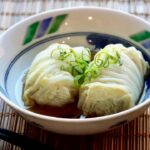
Stuffed Nappa Cabbage
Ingredients
Instructions
- Microwave Napa cabbage leaves until soft, about 4-5 mins. Slice off the thick white parts if they are too thick. Cool completely. Cut green onions very thinly. Slice ginger root thinly. Set all aside.
- Chop the sliced-off cabbage and brown onion finely. Combine the cabbage, brown onion, pork, Panko, egg, and salt in a bowl. Mix very well, then divide and shape the mixture into 8 oblong balls.
- Wrap each meatball with cabbage, tucking the end of the leaf under. Place the cabbage-wrapped meatballs in a pot that can accommodate all 8 pieces.
- Pour Dashi into the pot, heat it at medium heat, and cook for 10 minutes covered with parchment paper. Add soy sauce, Sake, Mirin, and sliced ginger. Cook for another 10 minutes, basting the stuffed cabbage with the soup from time to time.
- Salt to taste, and serve with sliced green onions on top.
Video
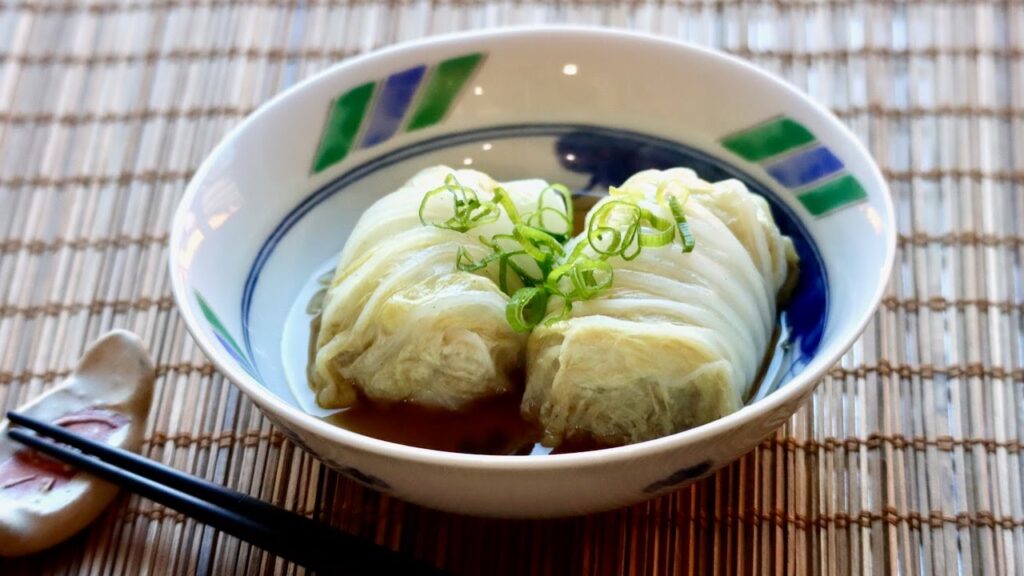
Mapo Tofu with Spinach and Mushroom
Mapo Tofu with Spinach and Mushroom is a healthy one-dish meal. Mapo Tofu (麻婆豆腐, more commonly known as Mabo Tofu in Japan) is originally from China, but it’s been well adapted in Japan. This is a variation of our home cooked Mabo Tofu with added spinach and mushroom. You can serve it over rice, and it becomes an easy and nutritious meal by itself. This is a perfect dinner to serve on a busy weekday.

Mapo Tofu with Spinach and Mushroom
Ingredients
- 1 block Tofu about 400g
- 3 green onions
- 1 cup mushrooms sliced
- 2 cups baby spinach
- 1 Tbsp oil
- 1 tsp garlic minced
- 1 tsp ginger minced
- 1 tsp crushed red/chili pepper
- 1/2 lb ground pork
- 1 Tbsp sesame oil
Sauce
- 2 Tbsp miso paste
- 2 Tbsp soy sauce
- 2 Tbsp sake
- 1 Tbsp sugar
- 1 Tbsp corn starch or katakuriko
- 1 cup water
Optional
Instructions
- Cut Tofu into 1″ cubes. Slice green onions thinly. Mince ginger and garlic and set aside. Slice mushroom. In a bowl, mix all the ingredients for the sauce until Miso dissolves. Set aside.
- Heat oil in a large skillet or a wok at medium heat, add garlic, ginger, and red pepper, and stir. Add the ground pork and cook until browned. Add the mushroom and spinach and cook until wilted. Add the sauce and let it boil. Add the cubed tofu and stir gently.
- When Tofu is cooked through, stir in green onions and sesame oil. Serve over rice (optional).
Video
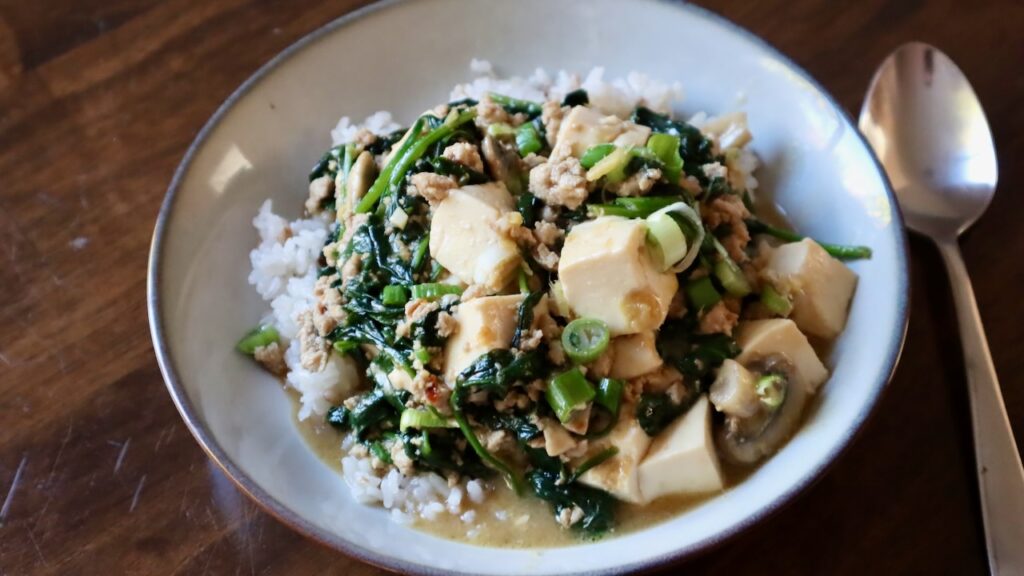
Onion Tomato Miso Soup
Today’s miso soup is made with white miso, sliced onion, and grape tomatoes. White miso is sweeter and milder than regular miso, and it tastes almost creamy. The flavor of the miso balances well with the tartness and umami from tomatoes.
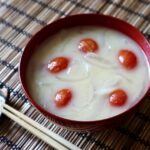
Onion Tomato Miso Soup
Ingredients
- 4 cups Dashi
- 1/2 onion sliced 1/4" thick
- 20 grape tomatoes
- 4-5 tbsp white miso paste or regular miso paste
Instructions
- Make the Dashi broth according to the recipe or use an instant dashi packet or powder. Bring the dashi to a boil and add the sliced onion. Cover and cook at medium low heat for 3 minutes. Add the tomatoes and cook for 2 more minutes.
- Turn off the heat and dissolve the miso paste.
Video
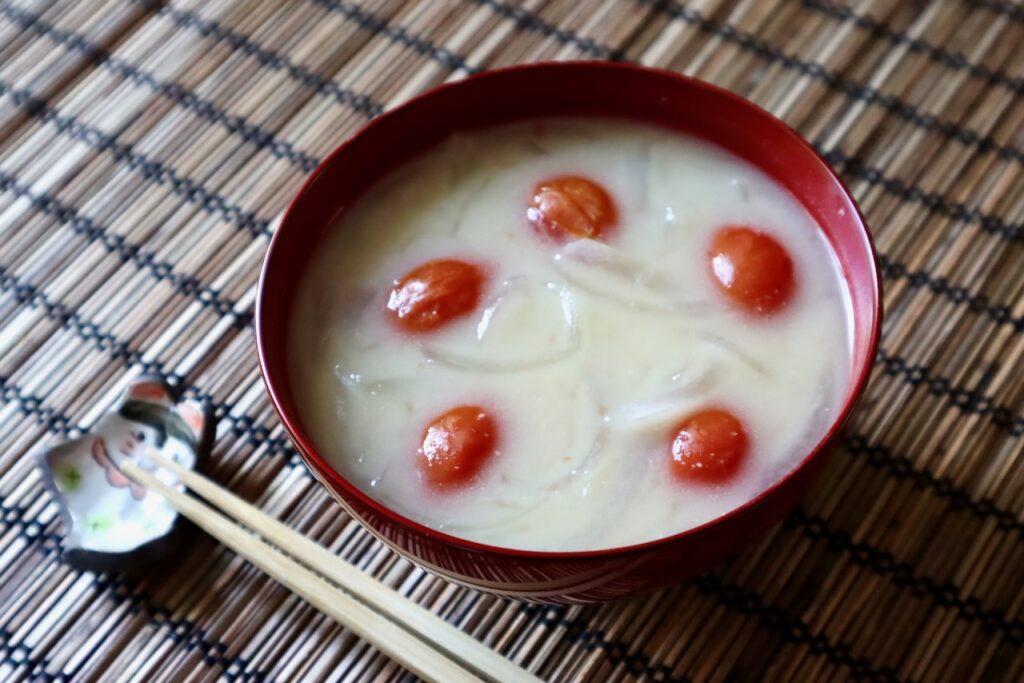
Beef Rolled Mochi Recipe
Beef Rolled Mochi is a dish where Mochi rice cake is wrapped and rolled with thinly sliced beef, then cooked in a sweet and salty Sukiyaki-style sauce. This is an excellent way to repurpose extra Mochi left over from the New Year’s feast.
People in Japan are always looking for creative ways to use unused Mochi bought for the New Year. We’ve previously shared several arrangements, such as Mochi with Nori-roasted seaweed, with grated Daikon radish, and with sweet soybean powder. Here’s a heartier option with beef. This dish can serve as a snack or a light meal, and its flavor is reminiscent of Sukiyaki, a popular choice for many. If you find yourself with surplus Mochi and are unsure what to do, give Beef Rolled Mochi a try. It’s so delicious that you might be tempted to buy more Mochi just to make this dish!
Beef Rolled Mochi
Ingredients
Instructions
- Cut mochi in half lengthwise. Cut sliced beef in half. Wrap and roll mochi sticks with beef to cover mochi completely.
- Heat oil in a frying pan over medium heat. Place beef in the pan and cook until lightly browned all around. Cover and cook for 2 minutes. Lower the heat and add soy sauce, sake, and sugar. Coat the sauce well. Serve immediately.
Video
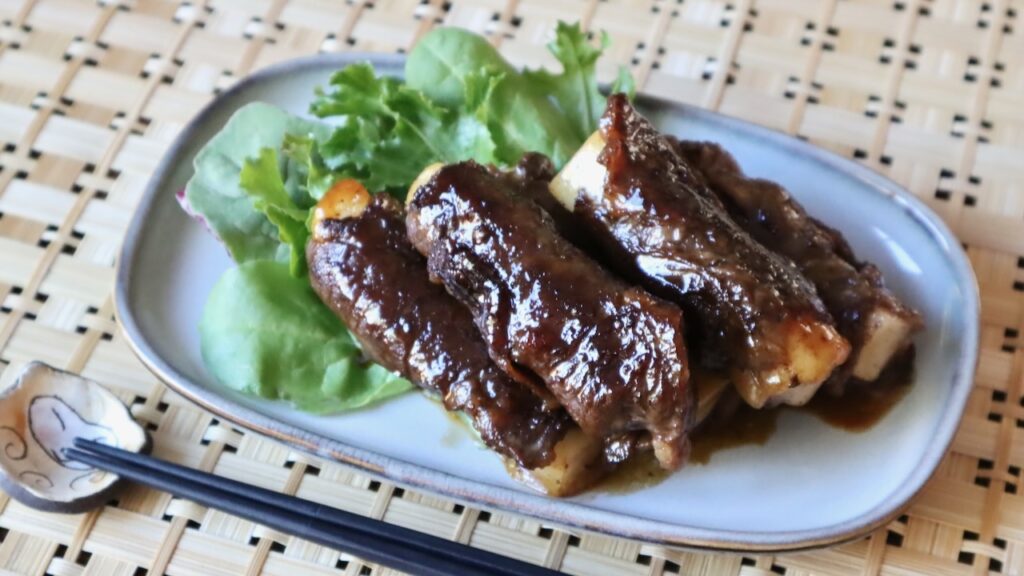

No comments:
Post a Comment